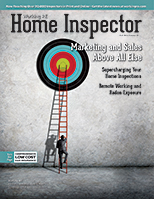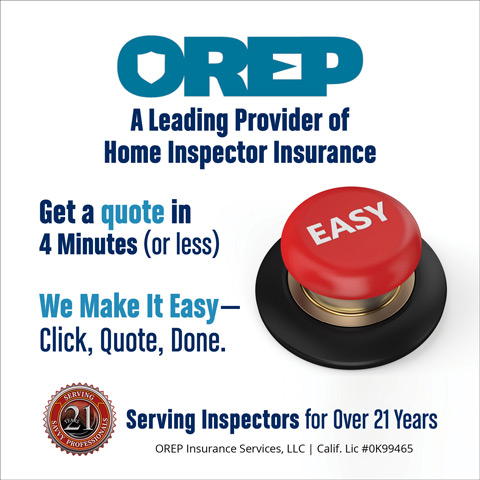 |
> E&O/GL Insurance for Home Inspectors Competitive Rates, Broad Coverage, Free Risk Management, online inspection support for tough questions, discounts on education and more… Professional Coverage, Competitive Pricing Shop OREP today! |
Remote Working Conditions Can Increase Home Radon Exposure
By Zan Jones, Radonova
Not only did the COVID-19 pandemic and work from home arrangements create health risks for home inspectors, it also may have exposed homeowners to additional unhealthy radon levels in their homes. Office buildings, hospitals, restaurants, and other public places often have advanced ventilation systems and indoor air quality protocols to protect the air people breathe. These same ventilation systems that focus on indoor air quality are not as prevalent in private residences.
An ongoing research study from the University of Calgary reveals that people spent more of their year in their primary residence after the COVID pandemic onset, which caused them to experience a 19.2 percent increase in radon exposure. In over 4,000 Canadian homes it was discovered the time spent within the home during the pandemic increased from 66.4 percent to 77 percent, which equates to 1,062 hours or more during a year.
Radon and Lung Cancer
Radon is a gas that forms when the uranium in the soil beneath a home decays into radioactive atoms and seeps into the home through cracks in the foundation, crawl spaces, and basements. It is considered a Group A carcinogen which means it is proven to cause cancer in humans. Spending more time in one’s home highlights the need for radon testing. Long-term exposure to radon especially causes a risk for developing lung cancer.
Radon has a 3.8-day half-life, which allows the gas to be trapped within indoor environments where it will decay into Polonium 218 and 214. When inhaled into the lungs, these radon decay products with shorter half-lives can decay into radioactive alpha particles that damage the DNA of cells lining the lungs. These cell changes are called mutations. When cells have too many mutations they can stop working correctly, grow uncontrollably, and become cancerous. Radon is the leading cause of lung cancer after smoking and is responsible for over 21,000 deaths per year in the United States.
Effects on Children and Young Adults
Children and young adults also spent more time within their homes during the pandemic. Social and extracurricular activities were canceled while schools and universities transitioned to remote classes. Educational settings have continued offering remote classes which further increases the time students spend inside their homes. This causes children and young adults to experience increased radon exposure at younger ages which can lead to lung cancer earlier in life.
Children have smaller lungs and faster breathing rates than adults, meaning they can inhale more radon gas. Children also have growing tissue and smaller bodies which makes them more affected by the radioactive radon they breathe in their homes. The “risk of lung cancer in children from exposure to radon may be almost twice as high as the risk to adults exposed to the same amount of radon,” the CDC Agency for Toxic Substances and Disease Registry states.
Energy Efficient Homes
The rise of energy-efficient and environmentally friendly homes contributes to increased home radon levels. The research titled “Radon Exposure is Rising Steadily Within the Modern North American Residential Environment and is Increasingly Uniform Across Seasons,” published in Nature’s Scientific Reports found a 31.5 percent increase in radon levels in homes built after 1992 compared to older houses. Modern houses are too efficient at limiting the amount of unregulated air coming in or out. Therefore, new homes in North America contain greater and greater radon levels.
Designed to be airtight, newer houses are designed to keep cool air inside during the hot summer months and then heat inside during the cold winter months. While doing so, newer houses are also trapping more radon within homes.
(story continues below)
(story continues)
One and Done
A home inspection may be the only time a home is tested for radon. The EPA recommends that homeowners test their homes for radon every two years. It is also recommended that homes be tested for radon after a major renovation, during alternate seasons, if residents begin occupying a lower level of the home (like the basement), and after installing a radon mitigation system.
However, a study published in Nature Portfolio analyzed how radon exposure disparities are driven by psychological and social factors—such as average time from awareness to receiving a radon test outcome, how quickly high radon levels were mitigated, and how delaying behaviors increased lifetime risks of lung cancer by as much as 30 to 40 percent. A striking observation was that almost half of the people who had “low” or “safe” radon levels stated they had no intention to test for radon again in the future. This highlights the importance of having accurate radon testing during a home inspection. A false negative outcome could increase lung cancer risks over a lifetime for those who decide not to test again.
Test and Mitigate if Radon Levels are High
As a result of the COVID pandemic, working from home and/or hybrid telecommuting has transformed from an emergency response to a situation that is here to stay. Working from home presents higher radon exposure risks that need to be considered by employers and employees alike. Energy-efficient homes save homeowners on their electric bills but can increase the radon exposure for those working from home or remaining home during school hours for remote education.
Employers have a responsibility to ensure the indoor environment where their employees work is safe. In the future, this responsibility could be applied to employees’ homes for workers required to work from home. If not, there may be a rise in lung cancer cases, especially impacting the younger generation.
Home inspections are even more critical at a time when homebuyers are opting out because of the housing demand. A home radon test can be provided by a certified professional or completed using a simple home test. If radon levels are above the actionable limit of 4.0 pCi/L then a radon mitigation system should be installed in the home by a certified professional to lower the radon levels. Here are some notable Radon stats:
• One in 15 homes in the United States have high radon levels
• 21,000 in the United States die from radon induced lung cancer every year
• 230,000 people worldwide lose their life to radon induced lung cancer every year
• Radon exposure at the actionable limit is equivalent to getting 200 chest x-rays per year or smoking seven to eight cigarettes per day
About Radonova
Radonova is the laboratory of choice for numerous public and private sector large-scale radon measurement projects around the world. A truly global laboratory, Radonova is active in over 50 countries and has performed millions of measurements.
About the Author
Zan Jones is the Vice President of Sales and Marketing for Radonova, Inc. in North America. As the global leader in radon measurement, Radonova has performed millions of radon measurements in over 50 countries around the world. Contact Zan about passive radon detectors, commercial radon instruments, or personal radon dosimeters via email at Zan.Jones@Radonova.com or call (331) 814-2200.
OREP Insurance Services, LLC. Calif. License #0K99465


